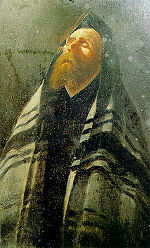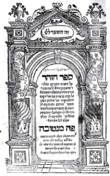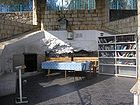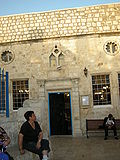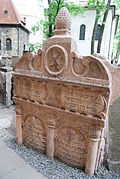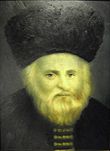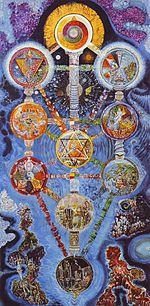- Kabbalah
-
This article is about traditional Jewish Kabbalah. For other Kabbalistic traditions see Christian Cabbalah, Hermetic Qabalah, and Practical Kabbalah
Part of a series on Kabbalah 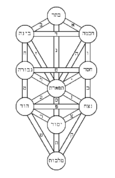 ConceptsEin Sof · Tzimtzum · Ohr
ConceptsEin Sof · Tzimtzum · Ohr
Ayin and Yesh · Sephirot
Four Worlds · Seder hishtalshelus
Tree of Life · Merkavah
Jewish angelic hierarchy
Shekhinah · Partzufim
Qliphoth · Tohu and Tikun
Sparks of holiness
Messianic rectification
Gilgul · Kabbalistic astrology
Gematria · Notarikon · Temurah
Names of God in Judaism · Shemhamphorasch
Tzadik · Tzadikim Nistarim
Anthropomorphism in Kabbalah
PanentheismHistoryEarly modern
Baal Shem-Nistarim
Sabbatean mystical heresies
Emden-Eybeschutz controversy
Immigration to the Land of Israel
Traditional Oriental Kabbalists
Beit El Synagogue
Eastern European Judaism
Hasidic Judaism / philosophy
Lithuanian Jews
Hasidic-Mitnagdic schismModern
Hasidic dynasties
PracticesTorah study · Mitzvot · Minhag
Customery immersion in Mikveh
Meditation · Deveikut · Prayer
Nusach · Kavanot · Teshuvah
Tikkun Chatzot
Tikkun Leil Shavuot
Pilgrimage to Tzadik
Pilgrimage to holy grave
Lag BaOmer at Meron
Asceticism · Practical KabbalahPeople100s
Four Who Entered the Pardes
Simeon bar Yochai1500s
Meir ibn Gabbai · Joseph Karo
Shlomo Alkabetz · Moshe Alshich
Moshe Cordovero
Isaac Luria · Chaim Vital
Judah Loew ben Bezalel1700s
Chaim ibn Attar · Baal Shem Tov
Dov Ber of Mezeritch
Moshe Chaim Luzzatto
Shalom Sharabi · Vilna Gaon
Chaim Joseph David Azulai
Nathan Adler
Schneur Zalman of Liadi
Chaim VolozhinRoleHistory
Torah · Tanakh · Prophecy
Ruach HaKodesh
Pardes exegesis
Talmudical hermeneutics
Midrash
Oral Torah
Eras of Rabbinic Judaism
Generational descent in Halacha
Generational ascent in Kabbalah
Rabbinic literature
Talmudic theology
Halakha · Aggadah · Hakira
Classic Mussar literature
Ashkenazi Judaism
Sephardi Judaism
Modern Jewish philosophies
Jewish studiesTopics
God in Judaism
Divine transcendence
Divine immanence · Free will
Divine providence
Jewish principles of faith
Jewish eschatologyKabbalah/Kabala (Hebrew: קַבָּלָה lit. "receiving"; often contemporary transliteration with a 'K' distinguishes from other, derivative traditions outside Judaism)[citation needed] is a discipline and school of thought concerned with the esoteric aspect of Rabbinic Judaism. It was systematized in 11th-13th century Hachmei Provence (Southern France) and Spain, and again after the Expulsion from Spain, in 16th century Ottoman Palestine. It was popularized in the form of Hassidic Judaism in the 18th century.
Kabbalah is a set of esoteric teachings meant to explain the relationship between an eternal and mysterious Creator and the mortal and finite universe (His creation). While it is heavily used by some denominations, it is not a denomination in and of itself; it is a set of scriptures that exist outside the traditional Jewish scriptures. Kabbalah seeks to define the nature of the universe and the human being, the nature and purpose of existence, and various other ontological questions. It also presents methods to aid understanding of these concepts and to thereby attain spiritual realization. Kabbalah originally developed entirely within the realm of Jewish thought and constantly uses classical Jewish sources to explain and demonstrate its esoteric teachings. These teachings are thus held by kabbalists to define the inner meaning of both the Tanakh (Hebrew Bible, תַּנַ"ךְ ) and traditional rabbinic literature, their formerly concealed transmitted dimension, as well as to explain the significance of Jewish religious observances.[1]
Contents
Overview
According to the Zohar (Hebrew :זֹהַר ), a foundational text for kabbalistic thought, Torah study can proceed along four levels of interpretation (exegesis).[2][3] These four levels are called Pardes because their initial letters spell "PaRDeS" ("Orchard"):
- Peshat (lit. "simple"): the direct interpretations of meaning.
- Remez (lit. "hint[s]"): the allegoric meanings (through allusion).
- Derash (from Heb. darash: "inquire" or "seek"): midrashic (Rabbinic) meanings, often with imaginative comparisons with similar words or verses.
- Sod (lit. "secret" or "mystery"): the inner, esoteric (metaphysical) meanings, expressed in kabbalah.
Kabbalah is considered, by its followers, as a necessary part of the study of Torah – the study of Torah (the "Teachings" of God, in the Tanach and Rabbinic literature) being an inherent duty of observant Jews.[4] Kabbalah teaches doctrines that are accepted by some Jews as the true meaning of Judaism while other Jews have rejected these doctrines as heretical and antithetical to Judaism. After the Medieval Kabbalah, and especially after its 16th century development and synthesis, Kabbalah replaced "Hakira" (Jewish philosophy) as the mainstream traditional Jewish theology, both in scholarly circles and in the popular imagination. With the arrival of modernity, through the influence of Haskalah, this has changed among non-Orthodox Jewish denominations, though its 20th century academic study and cross-denominational spiritual applications (especially through Neo-Hasidism) has reawakened a following beyond Orthodoxy.
The origins of the actual term Kabbalah are unknown and disputed to belong either to Jewish philosopher Solomon ibn Gabirol (1021–1058) or else to the 13th century Spanish Kabbalist Bahya ben Asher. While other terms have been used in many religious documents from the 2nd century up to the present day, the term "Kabbalah" has become the main descriptive of Jewish esoteric knowledge and practices. The Kabbalistic literature, which served as the basis for the development of Kabbalistic thought, developed through a theological tradition from Antiquity, as part of wider Rabbinic literature. Its theoretical development can be characterised in alternative schools and successive stages. These especially include the early works of the 1st-2nd centuries (such as the Heichalot texts and the earliest existent book on Jewish esotericism Sefer Yetzirah); the Medieval flowering of the 12th-13th century (of which the main book is the Zohar); and early-modern developments, including the mystical revivals of 16th century Safed (especially of Isaac Luria), and 18th century Eastern Europe (new Hasidic popularisations of Kabbalah).
According to Kabbalistic tradition, knowledge was transmitted orally by the Patriarchs, prophets, and sages (Hakhamim in Hebrew), eventually to be "interwoven" into Jewish religious writings and culture. According to this tradition, Kabbalah was, in around the 10th century BC, an open knowledge practiced by over a million people in ancient Israel.[5]
Foreign conquests drove the Jewish spiritual leadership of the time (the Sanhedrin) to hide the knowledge and make it secret, fearing that it might be misused if it fell into the wrong hands.[6] The Sanhedrin leaders were also concerned that the practice of Kabbalah by Jews deported on conquest to other countries (the Diaspora), unsupervised and unguided by the masters, might lead them into wrong practice and forbidden ways. As a result, the Kabbalah became secretive, forbidden and esoteric to Judaism ("Torat Ha’Sod" תורת הסוד) for two and a half millennia.
It is hard to clarify with any degree of certainty the exact concepts within Kabbalah. There are several different schools of thought with very different outlooks; however, all are accepted as correct.[7] Modern Halakhic authorities have tried to narrow the scope and diversity within Kabbalah, by restricting study to certain texts, notably Zohar and the teachings of Isaac Luria as passed down through Chaim (Hayyim) Vital.[8] However even this qualification does little to limit the scope of understanding and expression, as included in those works are commentaries on Abulafian writings, Sefer Yetzirah, Albotonian writings, and the Berit Menuhah,[9] which is known to the kabbalistic elect and which, as described more recently by Scholem, combined ecstatic with theosophical mysticism. It is therefore important to bear in mind when discussing things such as the Sefirot and their interactions that one is dealing with highly abstract concepts that at best can only be understood intuitively.[10]
Concepts
Kabbalistic understanding of God
 Metaphorical representation of Divine emanation of successively constricted Olamot (spiritual Worlds) within the surrounding Ein Sof (Divine Infinity)
Metaphorical representation of Divine emanation of successively constricted Olamot (spiritual Worlds) within the surrounding Ein Sof (Divine Infinity)
In Kabbalah all Creation unfolds from Divine reality. This view is found also in Rationalist Medieval Jewish philosophy (Hakira-"Investigation"), which offered a preceding, different approach to Jewish theology. However, the descriptions of Divinity in the two schools of thought differ, with Kabbalah elaborating a metaphysical structure of emanations from God, while Hakira investigates the ability to describe God beyond only negative descriptions. The Kabbalistic path, therefore, offers manifestations of Divinity that can be perceived in metaphorical anthropomorphic language, giving mystical dveikus (fervour) to the student. The two alternative approaches become united in intellectual articulations of Hasidic thought, from an inner perspective in Jewish mysticism.[11] The most important Medieval Jewish philosopher, Maimonides, famously summarised the Divine relation to Creation:
“ The foundation of all foundations, and the pillar of all wisdom is to know that there is God who brought into being all existence. All the beings of the heavens, and the earth, and what is between them came into existence only from the truth of God's being.[12] ” There has been traditional debate about whether Maimonides studied Kabbalah. Historical Kabbalistic commentaries were written on his Guide for the Perplexed, revealing deeper mystical layers beyond the regular Rationalist school.[13] Jewish philosophy questioned the limits and meaning of Divine understanding from man's thought, in harmony with exoteric Scriptural exegesis. In Kabbalah ("Received") understanding derives from Oral Torah traditions of esoteric Scriptural exegesis. As a metaphysical alternative to Halachic exegesis in Talmudical hermeneutics, Kabbalah similarly demonstrates its concepts from interpretation of Biblical and Rabbinic texts. These then become systemised and investigated philosophically. With the end of the scholarly culture of Muslim Spain, and the later Jewish expulsion, Kabbalah replaced Hakirah as Judaism's mainstream theology.
In the Kabbalistic scheme, God is neither matter nor spirit, but is the creator of both. The question of the Divine nature prompted Kabbalists to envision two aspects of God: (a) God Himself, who is ultimately unknowable, and (b) the revealed aspect of God that created the universe, preserves the universe, and interacts with mankind. Kabbalists speak of the first aspect of God as Ein Sof (אין סוף); this is translated as "the infinite", "endless", or "that which has no limits". In this view, nothing can be said about the essence of God. This aspect of God is impersonal. The second aspect of Divine emanations, however, is at least partially accessible to human thought. Kabbalists believe that these two aspects are not contradictory but, through the mechanism of progressive emanation, complement one another (See Divine simplicity). The structure of these emanations has been characterized in various ways: Sefirot (Divine attributes) and Partzufim (Divine "faces"); Four Worlds of Creation in a Seder hishtalshelus (Descending Chain of realms), Azilut, Beriyah, Yitzirah, and Asiyah; the Biblical vision by Ezekiel of the Merkabah (Divine angelic "Chariot"). These alternatives are harmonized in subsequent Kabbalistic systemisation. The central metaphor of Ohr ("Light") is used to describe Divine emanations.
 The Tetragrammaton in Phoenician (1100 B.C.E. to C.E. 300), Aramaic (10th Century B.C.E. to 0) and modern Hebrew scripts.
The Tetragrammaton in Phoenician (1100 B.C.E. to C.E. 300), Aramaic (10th Century B.C.E. to 0) and modern Hebrew scripts.Medieval Kabbalists believed that all things are linked to God through these emanations, making all levels in Creation part of one great, gradually descending chain of being. Through this any lower creation reflects its particular characteristics in Supernal Divinity. These descriptions reached their synthesis in 16th century CE Cordoveran Kabbalah. This metaphysical explanation gave cosmic significance to the deeds of man as the downward flow of the Divine "Light" that creates our reality that is opened or restricted according to the merits of each individual. Divine substenance in Creation is dependent on the traditional mitzvah observances of Judaism. Subsequent Kabbalah of Isaac Luria describes a radical origin to this depiction, where Creation unfolds from transcendent imbalance in Godliness, and the purpose of life is the Messianic rectification of Divinity by man. Once each person has completed their part of the rectification, the Messianic Era begins. In this, the mitzvot redeem the supernal Divine Sparks in existence. Later interpretations in Hasidism, such as by Schneur Zalman of Liadi, extend this radicalism by holding that God is all that really exists, all else being completely undifferentiated from God's perspective. This view can be defined as monistic panentheism. According to this philosophy, God's existence is higher than anything that this world can express, yet He includes all things of this world within His Divine reality in perfect unity, so that the Creation effected no change in Him at all. This paradox is dealt with at length in Habad texts.[14]
Sefirot and the Divine Feminine
The Sefirot (סְפִירוֹת — singular Sefirah סְפִירָה) are the ten emanations and attributes of God with which He continually sustains the universe in existence. The word "sefirah" literally means "counting", but early Kabbalists presented a number of other etymological possibilities including: sefer (book), sippur (story), sappir (sapphire, brilliance, luminary), separ (boundary), and safra (scribe). The term sefirah thus has complex connotations within Kabbalah.[15] The central metaphor of Man's soul is used to describe the Sefirot. This incorporates masculine and feminine aspects, after Genesis 1:27 ("God created man in His own image, in the image of God He created him, male and female He created them"). Corresponding to the last Sefirah in Creation is the indwelling Shechina (Feminine Divine Presence). In the Sefirot, performance of Mitzvot (traditional Jewish observances) unites the masculine and feminine aspects of supernal Divinity, and brings harmony to Creation. The description of Divine manifestation through the 10 Sefirot is a defining feature of Medieval Kabbalah, alongside their male and female aspects, and the concept of downward flow of Divine Light through the chain of Creation. The Sefirot correspond to the Four Worlds of this spiritual descent, Atziluth, Beri'ah, Yetzirah and Assiah.
Ten Sefirot as process of Creation
According to Lurianic cosmology, the Sefirot correspond to various levels of creation (ten sefirot in each of the Four Worlds, and four worlds within each of the larger four worlds, each containing ten sefirot, which themselves contain ten sefirot, to an infinite number of possibilities),[16] and are emanated from the Creator for the purpose of creating the universe. The Sefirot are considered revelations of the Creator's will (ratzon),[17] and they should not be understood as ten different "gods" but as ten different ways the one God reveals His will through the Emanations. It is not God who changes but the ability to perceive God that changes.
Altogether 11 sefirot are named. However Keter and Daat are unconscious and conscious dimensions of one principle, conserving 10 forces. The names of the Sefirot in descending order are:
- Keter (supernal crown, representing above-conscious will)
- Chochmah (the highest potential of thought)
- Binah (the understanding of the potential)
- Daat (intellect of knowledge)
- Chesed (sometimes referred to as Gedolah-greatness) (loving-kindness)
- Gevurah (sometimes referred to as Din-justice or Pachad-fear) (severity/strength)
- Rachamim also known as Tiphereth (mercy)
- Netzach (victory/eternity)
- Hod (glory/splendour)
- Yesod (foundation)
- Malkuth (kingdom)
Ten Sefirot as process of ethics
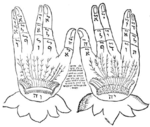 A hidden Kabbalistic practice focused on Kavanot (meditations) of Divine names. Angels elevated or blocked prayers in the ascending Worlds. The names were seen as keys to gates in Heaven, though simple tears of others could also open gates
A hidden Kabbalistic practice focused on Kavanot (meditations) of Divine names. Angels elevated or blocked prayers in the ascending Worlds. The names were seen as keys to gates in Heaven, though simple tears of others could also open gates
Divine creation by means of the Ten Sefirot is an ethical process. They represent the different aspects of Morality. Loving-Kindness is a possible moral justification found in Chessed, and Gevurah is the Moral Justification of Justice and both are mediated by Mercy which is Rachamim. However, these pillars of morality become immoral once they become extremes. When Loving-Kindness become extreme it can lead to sexual depravity and lack of Justice to the wicked. When Justice becomes extreme, it can lead to torture and the Murder of innocents and unfair punishment.
"Righteous" humans (Tzadikim) ascend these ethical qualities of the Ten Sefirot by doing righteous actions. If there were no "Righteous" humans, the blessings of God would become completely hidden, and creation would cease to exist. While real human actions are the "Foundation" (Yesod) of this universe (Malchut), these actions must accompany the conscious intention of compassion. Compassionate actions are often impossible without "Faith" (Emunah), meaning to trust that God always supports compassionate actions even when God seems hidden. Ultimately, it is necessary to show compassion toward oneself too in order to share compassion toward others. This "selfish" enjoyment of God's blessings but only in order to empower oneself to assist others, is an important aspect of "Restriction", and is considered a kind of golden mean in Kabbalah, corresponding to the Sefirah of "Adornment" (Tiferet) being part of the "Middle Column".
Moses ben Jacob Cordovero, wrote a book, Tomer Devorah (Palm Tree of Deborah), in which he presents an ethical teaching of Judaism in the kabbalistic context of the Ten Sefirot. Tomer Devorah, as a consequence, has become also a foundational Musar text.[18]
Human soul in Kabbalah
The Kabbalah posits that the human soul has three elements, the nefesh, ru'ach, and neshamah. The nefesh is found in all humans, and enters the physical body at birth. It is the source of one's physical and psychological nature. The next two parts of the soul are not implanted at birth, but can be developed over time; their development depends on the actions and beliefs of the individual. They are said to only fully exist in people awakened spiritually. A common way of explaining the three parts of the soul is as follows:
- Nefesh (נפש): the lower part, or "animal part", of the soul. It is linked to instincts and bodily cravings.
- Ruach (רוח): the middle soul, the "spirit". It contains the moral virtues and the ability to distinguish between good and evil.
- Neshamah (נשמה): the higher soul, or "super-soul". This separates man from all other life-forms. It is related to the intellect and allows man to enjoy and benefit from the afterlife. This part of the soul is provided at birth and allows one to have some awareness of the existence and presence of God.
The Raaya Meheimna, a section of related teachings spread throughout the Zohar, discusses fourth and fifth parts of the human soul, the chayyah and yehidah (first mentioned in the Midrash Rabbah). Gershom Scholem writes that these "were considered to represent the sublimest levels of intuitive cognition, and to be within the grasp of only a few chosen individuals". The Chayyah and the Yechidah do not enter into the body like the other three—thus they received less attention in other sections of the Zohar.
- Chayyah (חיה): The part of the soul that allows one to have an awareness of the divine life force itself.
- Yehidah (יחידה): The highest plane of the soul, in which one can achieve as full a union with God as is possible.
Both rabbinic and kabbalistic works posit that there are a few additional, non-permanent states of the soul that people can develop on certain occasions. These extra souls, or extra states of the soul, play no part in any afterlife scheme, but are mentioned for completeness:
- Ruach HaKodesh (רוח הקודש) ("spirit of holiness"): a state of the soul that makes prophecy possible. Since the age of classical prophecy passed, no one (outside of Israel) receives the soul of prophecy any longer. See the teachings of Abraham Abulafia for differing views of this matter.
- Neshamah Yeseira: The "supplemental soul" that a Jew can experience on Shabbat. It makes possible an enhanced spiritual enjoyment of the day. This exists only when one is observing Shabbat; it can be lost and gained depending on one's observance.
- Neshamah Kedosha: Provided to Jews at the age of maturity (13 for boys, 12 for girls), and is related to the study and fulfillment of the Torah commandments. It exists only when one studies and follows Torah; it can be lost and gained depending on one's study and observance.
Tzimtzum
Tzimtzum is the primordial cosmic act whereby God "contracted" His infinite light, leaving a "void" into which the light of existence was poured. This new doctrine of Isaac Luria in the 16th century gave a new organization of the previous Second-Temple and Medieval Kabbalistic concepts of Angelic hierarchies and descending Worlds. The primal emanation after the Tzimtzum in Lurianic Kabbalah led to an initial catastrophe called "Tohu" (Chaos). This was reformed into "Tikkun olam" (Rectification) of our spiritual realms, described in previous Kabbalah, becoming Atzilut (the World of Emanation), from which the three lower Worlds, Beriah, Yetzirah and Asiyah, descended. This corresponds to the reorganization of the Sefirot into the Partsufim described in previous Kabbalah. The Tzimtzum reconciles the infinite simplicity of the Ein Sof with the finite plurality of Creation. From the subsequent catastrophe stems the possibility of self-aware Creation, and also the Kelipot (impure "shells" in Medieval Kabbalah).
Mystical forms of Scriptural and Rabbinic exegesis
Kabbalah teaches that every Hebrew letter, word, number, even the accent on words of the Hebrew Bible contains a hidden sense; and it teaches the methods of interpretation for ascertaining these meanings. One such method is as follows:
As early as the 1st century BCE Jews believed that the Torah (first five books of the Hebrew Bible) and wider canonical texts contained encoded messages and hidden meanings. Gematria is one method for discovering its hidden meanings. Each letter in Hebrew also represents a number; Hebrew, unlike many other languages, never developed a separate numerical alphabet. By converting letters to numbers, Kabbalists were able to find a hidden meaning in each word. This method of interpretation was used extensively by various schools.
Primary texts
Main article: Kabbalah: Primary TextsLike the rest of the Rabbinic literature, the texts of Kabbalah were once part of an ongoing oral tradition, though, over the centuries, much of the oral tradition has been written down.
Jewish forms of esotericism existed over 2,000 years ago. Ben Sira (born c. 170 BCE) warns against it, saying: "You shall have no business with secret things".[20] Nonetheless, mystical studies were undertaken and resulted in mystical literature, the first being the Apocalyptic literature of the second and first pre-Christian centuries and which contained elements that carried over to later Kabbalah.
Throughout the centuries since, many texts have been produced, among them the ancient descriptions of Sefer Yetzirah, the Heichalot mystical ascent literature, the Bahir, Sefer Raziel HaMalakh and the Zohar, the main text of Kabbalistic exegesis. Classic mystical Bible commentaries are included in fuller versions of the Mikraot Gedolot (Main Commentators). Cordoveran systemisation is presented in Pardes Rimonim, philosophical articulation in the works of the Maharal, and Lurianic rectification in Etz Chayim. Subsequent interpretation of Lurianic Kabbalah was made in the writings of Shalom Sharabi, in Nefesh HaChaim and the 20th century Sulam. Hasidism interpreted Kabbalistic structures to their correspondence in inward perception.[21] The Hasidic development of Kabbalah incorporates a successive stage of Jewish mysticism from historical Kabbalistic metaphysics.[22]
Scholarship
Because it is by definition esoteric, no popular account (including an encyclopedia) can provide a complete, precise, and accurate explanation of the Kabbalah. However, a number of scholars from the Hebrew University of Jerusalem, including Gershom Scholem, Joseph Dan, Yehuda Liebes, Rachel Elior, and Moshe Idel,[23] as well as some from other locations, such as Arthur Green and Daniel Matt,[24] have made Kabbalist texts objects of modern scholarly scrutiny. Some scholars, notably Gershom Scholem and Martin Buber, have argued that modern Hassidic Judaism represents a popularization of the Kabbalah.[25] According to its adherents, intimate understanding and mastery of the Kabbalah brings one spiritually closer to God and enriches one's experience of Jewish sacred texts and law.
Claims for authority
Historians have noted that most claims for the authority of Kabbalah involve an argument of the antiquity of authority (see, e.g., Joseph Dan's discussion in his Circle of the Unique Cherub). As a result, virtually all works pseudepigraphically claim, or are ascribed, ancient authorship. For example, Sefer Raziel HaMalach, an astro-magical text partly based on a magical manual of late antiquity, Sefer ha-Razim, was, according to the kabbalists, transmitted to Adam by the angel Raziel after he was evicted from Eden.
Another famous work, the Sefer Yetzirah, supposedly dates back to the patriarch Abraham. This tendency toward pseudepigraphy has its roots in Apocalyptic literature, which claims that esoteric knowledge such as magic, divination and astrology was transmitted to humans in the mythic past by the two angels, Aza and Azaz'el (in other places, Azaz'el and Uzaz'el) who 'fell' from heaven (see Genesis 6:4).
Criticism
Dualism
Although Kabbalah propounds the Unity of God, one of the most serious and sustained criticisms is that it may lead away from monotheism, and instead promote dualism, the belief that there is a supernatural counterpart to God. The dualistic system holds that there is a good power versus an evil power. There are two primary models of Gnostic-dualistic cosmology: the first, which goes back to Zoroastrianism, believes creation is ontologically divided between good and evil forces; the second, found largely in Greco-Roman ideologies like Neo-Platonism, believes the universe knew a primordial harmony, but that a cosmic disruption yielded a second, evil, dimension to reality. This second model influenced the cosmology of the Kabbalah.
According to Kabbalistic cosmology, the Ten Sefirot correspond to ten levels of creation. These levels of creation must not be understood as ten different "gods" but as ten different ways of revealing God, one per level. It is not God who changes but the ability to perceive God that changes.
While God may seem to exhibit dual natures (masculine-feminine, compassionate-judgmental, creator-creation), all adherents of Kabbalah have consistently stressed the ultimate unity of God. For example, in all discussions of Male and Female, the hidden nature of God exists above it all without limit, being called the Infinite or the "No End" (Ein Sof)—neither one nor the other, transcending any definition. The ability of God to become hidden from perception is called "Restriction" (Tzimtzum). Hiddenness makes creation possible because God can become "revealed" in a diversity of limited ways, which then form the building blocks of creation.
Kabbalistic texts, including the Zohar, appear to affirm dualism, as they ascribe all evil to the separation from holiness known as the Sitra Achra[26] ("the other side") which is opposed to Sitra D’Kedushah, or the Side of Holiness.[27] The "left side" of divine emanation is a negative mirror image of the "side of holiness" with which it was locked in combat. [Encyclopaedia Judaica, Volume 6, "Dualism", p. 244]. While this evil aspect exists within the divine structure of the Sefirot, the Zohar indicates that the Sitra Ahra has no power over Ein Sof, and only exists as a necessary aspect of the creation of God to give man free choice, and that evil is the consequence of this choice. It is not a supernatural force opposed to God, but a reflection of the inner moral combat within mankind between the dictates of morality and the surrender to one's basic instincts.
Rabbi Dr. David Gottlieb notes that many Kabbalists hold that the concepts of, e.g., a Heavenly Court or the Sitra Ahra are only given to humanity by God as a working model to understand His ways within our own epistemological limits. They reject the notion that a satan or angels actually exist. Others hold that non-divine spiritual entities were indeed created by God as a means for exacting his will.
According to Kabbalists, humans cannot yet understand the infinity of God. Rather, there is God as revealed to humans (corresponding to Zeir Anpin), and the rest of the infinity of God as remaining hidden from human experience (corresponding to Arich Anpin).[28] One reading of this theology is monotheistic, similar to panentheism; another reading of the same theology is that it is dualistic. Gershom Scholem writes:
“ It is clear that with this postulate of an impersonal basic reality in God, which becomes a person—or appears as a person—only in the process of Creation and Revelation, Kabbalism abandons the personalistic basis of the Biblical conception of God....It will not surprise us to find that speculation has run the whole gamut—from attempts to re-transform the impersonal En-Sof into the personal God of the Bible to the downright heretical doctrine of a genuine dualism between the hidden Ein Sof and the personal Demiurge of Scripture.
— Major Trends in Jewish Mysticism Shocken Books (p.11–12)” Perception of non-Jews
Many Kabbalistic sources contain statements to the effect that the Jewish soul is ontologically different from the soul of non-Jews; for example, it is held by some that Jews have three levels of soul, nefesh, ruach and neshamah while non-Jews have only nefesh. The Zohar comments on the Biblical verse which states "Let the waters teem with swarms of creatures that have a living soul" as follows: "The verse 'creatures that have a living soul,' pertains to the Jews, for they are the children of God, and from God come their holy souls....And the souls of the other nations, from where do they come? Rabbi Elazar says that they have souls from the impure left side, and therefore they are all impure, defiling anyone who comes near them" (Zohar commentary on Genesis).
Such theologically framed hostility may have been a response to some medieval demonization of Jews which developed in some parts of Western and Christian society and thought, starting with the Patristic writings.[29]; however it is also the case that passages asserting Jewish specialness or uniqueness are present in pre-Christian texts (such as The Book of Joshua, Deuteronomy, etc.). According to Isaac Luria and other commentators on the Zohar, righteous Gentiles do not have this demonic aspect and are in many ways similar to Jewish souls. A number of prominent Kabbalists, e.g. Rabbi Pinchas Eliyahu of Vilna, the author of Sefer ha-Brit, held that only some marginal elements in the humanity represent these demonic forces. On the other hand, the souls of Jewish heretics have much more satanic energy than the worst of idol worshippers; this view is popular in some Hasidic circles, especially Satmar Hasidim.
Some later Kabbalistic works build and elaborate on these ideas. One point of view is represented by the Hasidic work Tanya, which stresses the uniqueness of the Jewish soul,[citation needed] in order to argue that Jews have an additional level of soul. While a non-Jew, according to Rabbi Shneur Zalman of Liadi, can achieve a high level of spiritually, similar to an angel, his soul is still fundamentally different in character, but not value, from a Jewish one.[30] A similar view is found in Yehuda Halevi's medieval philosophical book Kuzari.
On the other hand, many prominent Kabbalists rejected this idea and believed in essential equality of all human souls. Menahem Azariah da Fano, in his book Reincarnations of souls, provides many examples of non-Jewish Biblical figures being reincarnated into Jews and vice versa; the contemporary Habad Rabbi and mystic Dov Ber Pinson teaches that seemingly discriminatory statements in the Tanya and other Kabbalistic works are not to be understood literally.[31]
Another prominent Habad Rabbi, Abraham Yehudah Khein, believed that spiritually elevated Gentiles have essentially Jewish souls, "who just lack the formal conversion to Judaism", and that unspiritual Jews are "Jewish merely by their birth documents".[32] The great 20th century Kabbalist Yehuda Ashlag viewed the terms "Jews" and "Gentile" as different levels of perception, available to every human soul.
David Halperin[33] argues that the collapse of Kabbalah's influence among Western European Jews over the course of the 17th and 18th century was a result of the cognitive dissonance they experienced between the negative perception of Gentiles found in some exponents of Kabbalah, and their own positive dealings with non-Jews, which were rapidly expanding and improving during this period due to the influence of the Enlightenment.
However, a number of renown Kabbalists claimed the exact opposite. In their view, Kabbalah transcends the borders of Judaism and can serve as a basis of inter-religious theosophy and a universal religion. Rabbi Pinchas Elijah Hurwitz, a prominent Lithuanian-Galician Kabbalist of the 18th century and a moderate proponent of the Haskalah, called for brotherly love and solidarity between all nations, and believed that Kabbalah can empower everyone, Jews and Gentiles alike, with prophetic abilities.[34]
The works of Abraham Cohen de Herrera are full of references to Gentile mystical philosophers. Such approach was particularly common among the Renaissance and post-Renaissance Italian Jews. A number of Italian Kabbalists, e.g. Yohanan Alemanno, David Messer Leon and Abraham Yagel, adhered to humanistic ideals and incorporated teachings of various Christian and pagan mystics.
A prime representative of this humanist stream in Kabbalah was Rabbi Elijah Benamozegh, who explicitly praised Christianity, Islam, Zoroastrianism, Hinduism, as well as a whole range of ancient pagan mystical systems. He believed that Kabbalah can reconcile the differences between the world religions, which represent different facets and stages of the universal human spirituality. In his writings, Benamozegh interprets the New Testament, Hadith, Vedas, Avesta and pagan mysteries according to the Kabbalistic theosophy.[35]
For a different perspective, see Wolfson.[36] He provides numerous examples from the 17th to the 20th centuries, which would challenge the view of Halperin cited above as well as the notion that "modern Judaism" has rejected or dismissed this "outdated aspect" of the religion and, he argues, there are still Kabbalists today who harbor this view. He argues that, while it is accurate to say that many Jews do and would find this distinction offensive, it is inaccurate to say that the idea has been totally rejected in all circles. As Wolfson has argued, it is an ethical demand on the part of scholars to continue to be vigilant with regard to this matter and in this way the tradition can be refined from within.
However, as explained above, many well known Kabbalists rejected the literal interpretation of these seemingly discriminatory views. They argued that the term "Jew" was to be interpreted metaphorically, as referring to the spiritual development of the soul, rather than the superficial denomination of the individual, and they added a chain of intermediary states between "Jews" and idol worshippers, or spiritualized the very definition of "Jews" and "non-Jews" and argued that a soul can be re-incarnated in different communities (whether Jewish or not) as much as within a single one.[31]
Medieval Views
The idea that there are ten divine sefirot could evolve over time into the idea that "God is One being, yet in that One being there are Ten" which opens up a debate about what the "correct beliefs" in God should be, according to Judaism.
Rabbi Saadia Gaon teaches in his book Emunot v'Deot that Jews who believe in reincarnation have adopted a non-Jewish belief.
Maimonides (12th century) rejected many of the texts of the Hekalot, particularly Shi'ur Qomah whose starkly anthropomorphic vision of God he considered heretical.
Nachmanides (13th century) provides background to many Kabbalistic ideas. His works, especially those in the Five books of Moses (Pentateuch) offer in-depth of various concepts.
Rabbi Abraham ben Moses ben Maimon, in the spirit of his father Maimonides, Rabbi Saadiah Gaon, and other predecessors, explains at length in his book Milhhamot HaShem that the Almighty is in no way literally within time or space nor physically outside time or space, since time and space simply do not apply to His Being whatsoever. This is in contrast to certain popular understandings of modern Kabbalah which teach a form of panentheism, that His 'essence' is within everything.
Around the 1230s, Rabbi Meir ben Simon of Narbonne wrote an epistle (included in his Milhhemet Mitzvah) against his contemporaries, the early Kabbalists, characterizing them as blasphemers who even approach heresy. He particularly singled out the Sefer Bahir, rejecting the attribution of its authorship to the tanna R. Nehhunya ben ha-Kanah and describing some of its content as truly heretical.
Rabbi Yitzchak ben Sheshet Perfet (The Rivash), 1326–1408. Although as is evident from his response on the topic (157) the Rivash was skeptical of certain interpretations of Kabbalah popular in his time, it is equally evident that overall he did accept Kabbalah as received Jewish wisdom, and attempted to defend it from attackers. To this end he cited and rejected a certain philosopher who claimed that Kabbalah was "worse than Christianity", as it made God into 10, not just into three. Most followers of Kabbalah have never followed this interpretation of Kabbalah, on the grounds that the concept of the Christian Trinity posits that there are three persons existing within the Godhead, one of whom became a human being.[citation needed] In contrast, the mainstream understanding of the Kabbalistic Sefirot holds that they have no mind or intelligence; further, they are not addressed in prayer and they cannot become a human being. They are conduits for interaction, not persons or beings. Nonetheless, many important poskim, such as Maimonidies in his work Mishneh Torah, prohibit any use of mediators between oneself and the Creator as a form of idolatry.
Rabbi Leone di Modena, a 17th century Venetian critic of Kabbalah, wrote that if we were to accept the Kabbalah, then the Christian trinity would indeed be compatible with Judaism, as the Trinity closely resembles the Kabbalistic doctrine of the Sefirot. This critique was in response to the knowledge that some European Jews of the period addressed individual Sefirot in some of their prayers, although the practise was apparently uncommon. Apologists explain that Jews may have been praying for and not necessarily to the aspects of Godliness represented by the Sefirot.
Rabbi Yaakov Emden, 1697–1776, wrote the book Mitpahhath Sfarim (Veil of the Books), a detailed critique of the Zohar in which he concludes that certain parts of the Zohar contain heretical teaching and therefore could not have been written by Rabbi Shimon bar Yochai. Opponents of his work claim[citation needed] that he wrote the book in a drunken stupor. Emden's rationalistic approach to this work, however, makes neither intoxication nor stupor seem plausible.
Rabbi Yihhyah Qafahh, an early 20th century Yemenite Jewish leader and grandfather of Rabbi Yosef Qafih, also wrote a book entitled Milhhamoth HaShem (Wars of the L-RD) against what he perceived as the false teachings of the Zohar and the false Kabbalah of Isaac Luria. He is credited with spearheading the Dor Daim who continue in R. Yihhyah Qafahh's view of Kabbalah into modern times.
Orthodox Judaism
Yeshayahu Leibowitz 1903–1994, brother of Nechama Leibowitz, though Modern Orthodox in his world view, publicly shared the views expressed in R. Yihhyah Qafahh's book Milhhamoth HaShem and elaborated upon these views in his many writings.
There is dispute among modern Haredim as to the status of Isaac Luria's, the Arizal's Kabbalistic teachings. While a portion of Modern Orthodox Rabbis, Dor Daim and many students of the Rambam, completely reject Arizal's Kabbalistic teachings, as well as deny that the Zohar is authoritative, or from Shimon bar Yohai, all three of these groups completely accept the existence and validity of Ma'aseh Merkavah and Ma'aseh B'resheet mysticism. Their only disagreement concerns whether the Kabbalistic teachings promulgated today are accurate representations of those esoteric teachings to which the Talmud refers. Within the Haredi Jewish community one can find both rabbis who sympathize with such a view,[citation needed] while not necessarily agreeing with it, as well as rabbis who consider such a view absolute heresy.
Conservative, Reform and Reconstructionist Judaism
Kabbalah tended to be rejected by most Jews in the Conservative and Reform movements, though its influences were not completely eliminated. While it was generally not studied as a discipline, the Kabbalistic Kabbalat Shabbat service remained part of liberal liturgy, as did the Yedid Nefesh prayer. Nevertheless, in the 1960s, Rabbi Saul Lieberman of the Jewish Theological Seminary of America is reputed to have introduced a lecture by Scholem on Kabbalah with a statement that Kabbalah itself was "nonsense", but the academic study of Kabbalah was "scholarship". This view became popular among many Jews, who viewed the subject as worthy of study, but who did not accept Kabbalah as teaching literal truths.
According to Rabbi Bradley Shavit Artson (Dean of the Conservative Ziegler School of Rabbinic Studies in the American Jewish University)
“ Many western Jews insisted that their future and their freedom required shedding what they perceived as parochial orientalism. They fashioned a Judaism that was decorous and strictly rational (according to 19th-century European standards), denigrating Kabbalah as backward, superstitious, and marginal.[37] ” However, in the late 20th century and early 21st century there has been a revival in interest in Kabbalah in all branches of liberal Judaism. The Kabbalistic 12th century prayer Anim Zemirot was restored to the new Conservative Sim Shalom siddur, as was the B'rikh Shmeh passage from the Zohar, and the mystical Ushpizin service welcoming to the Sukkah the spirits of Jewish forbearers. Anim Zemirot and the 16th century mystical poem Lekhah Dodi reappeared in the Reform Siddur Gates of Prayer in 1975. All Rabbinical seminaries now teach several courses in Kabbalah—in Conservative Judaism, both the Jewish Theological Seminary and the Ziegler School of Rabbinical Studies of the University of Judaism in Los Angeles have fulltime instructors in Kabbalah and Hasidut, Eitan Fishbane and Pinchas Geller, respectively. In the Reform movement Sharon Koren teaches at the Hebrew Union College. Reform Rabbis like Herbert Weiner and Lawrence Kushner have renewed interest in Kabbalah among Reform Jews. At the Reconstructionist Rabbinical College, the only accredited seminary that has curricular requirements in Kabbalah, Joel Hecker is the fulltime instructor teaching courses in Kabbalah and Hasidut.
According to Artson:
“ Ours is an age hungry for meaning, for a sense of belonging, for holiness. In that search, we have returned to the very Kabbalah our predecessors scorned. The stone that the builders rejected has become the head cornerstone (Psalm 118:22)... Kabbalah was the last universal theology adopted by the entire Jewish people, hence faithfulness to our commitment to positive-historical Judaism mandates a reverent receptivity to Kabbalah.[38] ” The Reconstructionist movement, under the leadership of Arthur Green in the 1980s and 1990s, and with the influence of Zalman Schachter Shalomi, brought a strong openness to Kabbalah and hasidic elements that then came to play prominent roles in the Kol ha-Neshamah siddur series.
History
Origins of Judaic mysticism
According to the traditional understanding, Kabbalah dates from Eden.[39] It came down from a remote past as a revelation to elect Tzadikim (righteous people), and, for the most part, was preserved only by a privileged few. Talmudic Judaism records its view of the proper protocol for teaching this wisdom, as well as many of its concepts, in the Talmud, Tractate Hagigah, Ch.2.
Contemporary scholarship suggests that various schools of Jewish esotericism arose at different periods of Jewish history, each reflecting not only prior forms of mysticism, but also the intellectual and cultural milieu of that historical period. Answers to questions of transmission, lineage, influence, and innovation vary greatly and cannot be easily summarized.
Origins of terms
Originally, Kabbalistic knowledge was believed to be an integral part of the Judaism's oral law (see also Aggadah), given by God to Moses on Mount Sinai around 13th century BCE, though there is a view that Kabbalah began with Adam.
When the Israelites arrived at their destination and settled in Canaan, for a few centuries the esoteric knowledge was referred to by its aspect practice—meditation Hitbonenut (Hebrew: התבוננות),[40] Rebbe Nachman of Breslov's Hitbodedut (Hebrew: התבודדות), translated as "being alone" or "isolating oneself", or by a different term describing the actual, desired goal of the practice—prophecy ("NeVu’a" Hebrew: נבואה).
During the 5th century BCE, when the works of the Tanakh were edited and canonized and the secret knowledge encrypted within the various writings and scrolls ("Megilot"), the knowledge was referred to as Ma'aseh Merkavah (Hebrew: מעשה מרכבה)[41] and Ma'aseh B'reshit (Hebrew: מעשה בראשית),[42] respectively "the act of the Chariot" and "the act of Creation". Merkavah mysticism alluded to the encrypted knowledge within the book of the prophet Ezekiel describing his vision of the "Divine Chariot". B'reshit mysticism referred to the first chapter of Genesis (Hebrew: בראשית) in the Torah that is believed to contain secrets of the creation of the universe and forces of nature. These terms are also mentioned in the second chapter of the Talmudic tractate Haggigah.
Mystic elements of the Torah
 Ezekiel and Isaiah had prophetic visions of the angelic Chariot and Divine Throne. Later Kabbalah relates their narratives to the Four Worlds. In Judaism the only permitted images of angels was on the Ark of the Covenant
Ezekiel and Isaiah had prophetic visions of the angelic Chariot and Divine Throne. Later Kabbalah relates their narratives to the Four Worlds. In Judaism the only permitted images of angels was on the Ark of the Covenant
According to adherents of Kabbalah, its origin begins with secrets that God revealed to Adam. According to a rabbinic midrash[citation needed] God created the universe through the Ten Sefirot. When read by later generations of Kabbalists, the Torah's description of the creation in the Book of Genesis reveals mysteries about the godhead itself, the true nature of Adam and Eve, the Garden of Eden, the Tree of Knowledge of Good and Evil and the Tree of Life, as well as the interaction of these supernal entities with the Serpent which leads to disaster when they eat the forbidden fruit, as recorded in Genesis 2.[38]
The Bible provides ample additional material for mythic and mystical speculation. The prophet Ezekiel's visions in particular attracted much mystical speculation, as did Isaiah's Temple vision—Isaiah, Ch.6. Jacob's vision of the ladder to heaven provided another example of esoteric experience. Moses' encounters with the Burning bush and God on Mount Sinai are evidence of mystical events in the Tanakh that form the origin of Jewish mystical beliefs.
The 72 letter name of God which is used in Jewish mysticism for meditation purposes is derived from the Hebrew verbal utterance Moses spoke in the presence of an angel, while the Sea of Reeds parted, allowing the Hebrews to escape their approaching attackers. The miracle of the Exodus, which led to Moses receiving the Ten Commandments and the Jewish Orthodox view of the acceptance of the Torah at Mount Sinai, preceded the creation of the first Jewish nation approximately three hundred years before King Saul.
Mystical doctrines in the Talmudic era
 The grave of Shimon bar Yochai in Meron before 1899. A Talmudic Tanna, he is the mystical teacher in the central Kabbalistic work, the Zohar
The grave of Shimon bar Yochai in Meron before 1899. A Talmudic Tanna, he is the mystical teacher in the central Kabbalistic work, the Zohar
In early rabbinic Judaism (the early centuries of the first millennium CE), the terms Ma'aseh Bereshit ("Works of Creation") and Ma'aseh Merkabah ("Works of the Divine Throne/Chariot") clearly indicate the Midrashic nature of these speculations; they are really based upon Genesis 1 and Book of Ezekiel 1:4–28; while the names Sitrei Torah (Hidden aspects of the Torah) (Talmud Hag. 13a) and Razei Torah (Torah secrets) (Ab. vi. 1) indicate their character as secret lore. An additional term also expanded Jewish esoteric knowledge, namely Chochmah Nistara (Hidden wisdom).
Talmudic doctrine forbade the public teaching of esoteric doctrines and warned of their dangers. In the Mishnah (Hagigah 2:1), rabbis were warned to teach the mystical creation doctrines only to one student at a time.[43] To highlight the danger, in one Jewish aggadic ("legendary") anecdote, four prominent rabbis of the Mishnaic period (1st century CE) are said to have visited the Orchard (that is, Paradise, pardes, Hebrew: פרדס lit., orchard):
“ Four men entered pardes—Ben Azzai, Ben Zoma, Acher (Elisha ben Abuyah),[44] and Akiba. Ben Azzai looked and died; Ben Zoma looked and went mad; Acher destroyed the plants; Akiba entered in peace and departed in peace.[45] ” In notable readings of this legend, only Rabbi Akiba was fit to handle the study of mystical doctrines. The Tosafot, medieval commentaries on the Talmud, say that the four sages "did not go up literally, but it appeared to them as if they went up".[46] On the other hand, Rabbi Louis Ginzberg, writes in the Jewish Encyclopedia (1901–1906) that the journey to paradise "is to be taken literally and not allegorically".[47] For further analysis, see The Four Who Entered Paradise.
Middle Ages
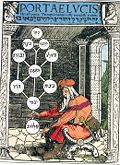 The Medieval era began esoteric circles of Kabbalistic dissemination in French Provence, Andalusian Spain and Germany-Ashkenaz
The Medieval era began esoteric circles of Kabbalistic dissemination in French Provence, Andalusian Spain and Germany-Ashkenaz
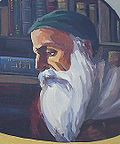 The 13th century Nachmanides, a classic figure in Rabbinic theology, was an early exponent of Kabbalah
The 13th century Nachmanides, a classic figure in Rabbinic theology, was an early exponent of Kabbalah
From the 8th–11th century Sefer Yetzirah and Hekalot texts made their way into European Jewish circles. Modern scholars have identified several mystical brotherhoods that functioned in Europe starting in the 12th century. Some, such as the "Iyyun Circle" and the "Unique Cherub Circle", were truly esoteric, remaining largely anonymous.
One well-known group was the "Hasidei Ashkenaz" (חסידי אשכנז) or German Pietists. This 13th century movement arose mostly among a single scholarly family, the Kalonymus family of the French and German Rhineland.
There were certain rishonim ("Elder Sages") of exoteric Judaism who are known to have been experts in Kabbalah. One of the best known is Nahmanides (the Ramban) (1194–1270) whose commentary on the Torah is considered to be based on Kabbalistic knowledge. Bahya ben Asher (the Rabbeinu Behaye) (d. 1340) also combined Torah commentary and Kabbalah. Another was Isaac the Blind (1160–1235), the teacher of Nahmanides, who is widely argued to have written the first work of classic Kabbalah, the Bahir.
Sefer Bahir and another work, the "Treatise of the Left Emanation", probably composed in Spain by Isaac ben Isaac ha-Kohen, laid the groundwork for the composition of Sefer Zohar, written by Moses de Leon and his mystical circle at the end of the 13th century, but credited to the Talmudic sage Shimon bar Yochai, cf. Zohar. The Zohar proved to be the first truly "popular" work of Kabbalah, and the most influential. From the 13th century onward, Kabbalah began to be widely disseminated and it branched out into an extensive literature. Historians in the 19th century, for example, Heinrich Graetz, argued that the emergence into public view of Jewish esotericism at this time coincides with, and represents a response to, the rising influence of the rationalist philosophy of Maimonides and his followers. Gershom Scholem sought to undermine this view as part of his resistance to seeing Kabbalah as merely a response to medieval Jewish rationalism. Arguing for a gnostic influence has to be seen as part of this strategy. More recently, Moshe Idel and Elliot Wolfson have independently argued that the impact of Maimonides can be seen in the change from orality to writing in the 13th century. That is, Kabbalists committed to writing many of their oral traditions in part as a response to the attempt of Maimonides to explain the older esoteric subjects philosophically.
Most Orthodox Jews reject the idea that Kabbalah underwent significant historical development or change such as has been proposed above. After the composition known as the Zohar was presented to the public in the 13th century, the term "Kabbalah" began to refer more specifically to teachings derived from, or related, to the Zohar. At an even later time, the term began to generally be applied to Zoharic teachings as elaborated upon by Isaac Luria Arizal. Historians generally date the start of Kabbalah as a major influence in Jewish thought and practice with the publication of the Zohar and climaxing with the spread of the Arizal's teachings. The majority of Haredi Jews accept the Zohar as the representative of the Ma'aseh Merkavah and Ma'aseh B'reshit that are referred to in Talmudic texts.[48]
Early Modern era: Lurianic Kabbalah
The mystical community in 16th century Safed invigorated wider Judaism with its Cordoveran synthesis and Lurianic reorganisation
Following the upheavals and dislocations in the Jewish world as a result of the Spanish Inquisition, the expulsion of the Jews from Spain in 1492, and the trauma of Anti-Semitism during the Middle Ages, Jews began to search for signs of when the long-awaited Jewish Messiah would come to comfort them in their painful exiles. Moses Cordovero and his immediate circle popularized the teachings of the Zohar which had until then been only a modestly influential work. The author of the Shulkhan Arukh (the Jewish "Code of Law"), Rabbi Yosef Karo (1488–1575), was also a great scholar of Kabbalah and spread its teachings during this era.
As part of that "search for meaning" in their lives, Kabbalah received its biggest boost in the Jewish world with the explication of the Kabbalistic teachings of Rabbi Isaac Luria (1534–1572) by his disciples Rabbi Hayim Vital and Rabbi Israel Sarug, both of whom published Luria's teachings (in variant forms) gaining them widespread popularity. Luria's teachings came to rival the influence of the Zohar and Luria stands, alongside Moses de Leon, as the most influential mystic in Jewish history.
Ban on studying Kabbalah
The ban against studying Kabbalah was lifted by the efforts of the 16th century Kabbalist Rabbi Avraham Azulai (1570–1643).
“ I have found it written that all that has been decreed Above forbidding open involvement in the Wisdom of Truth [Kabbalah] was [only meant for] the limited time period until the year 5,250 (1490 C.E.). From then on after is called the "Last Generation", and what was forbidden is [now] allowed. And permission is granted to occupy ourselves in the [study of] Zohar. And from the year 5,300 (1540 C.E.) it is most desirable that the masses both those great and small [in Torah], should occupy themselves [in the study of Kabbalah], as it says in the Raya M'hemna [a section of the Zohar]. And because in this merit King Mashiach will come in the future—and not in any other merit—it is not proper to be discouraged [from the study of Kabbalah]. (Rabbi Avraham Azulai)[49] ” The question however is whether the ban ever existed in the first place. Concerning the above quote by Avraham Azulai, it has found many versions in English, another is this
“ From the year 1540 and onward, the basic levels of Kabbalah must be taught publicly to everyone, young and old. Only through Kabbalah will we forever eliminate war, destruction, and man's inhumanity to his fellow man.[50] ” The lines concerning 1490 are also missing from the Hebrew edition of Hesed L'Avraham, the source work that both of these quote from. Furthermore by Azulai's view the ban was lifted thirty years before his birth. A time that would have corresponded with Rabbi Haim Vital's publication of the teaching of Isaac Luria. Furthermore Rabbi Moshe Isserles only understood there to be a minor restriction, in his words, "One's belly must be full of meat and wine, discerning between the prohibited and the permitted."[51] He is supported by the Bier Hetiv, the Pithei Teshuva as well as the Vilna Gaon. The Vilna Gaon says,
“ There was never any ban or enactment restricting the study of the wisdom of Kabbalah. Any who says there is has never studied Kabbalah, has never seen PaRDeS, and speaks as an ignoramous.[52] ” Thus leaving the existence of a ban to be highly debated.
Sefardi and Mizrahi
The Kabbalah of the Sefardi (Portuguese or Spanish) and Mizrahi (Middle East, North Africa, and the Caucasus) Torah scholars has a long history. Kabbalah in various forms was widely studied, commented upon, and expanded by North African, Turkish, Yemenite, and Asian scholars from the 16th century onward. It flourished among Sefardic Jews in Tzfat (Safed), Israel even before the arrival of Isaac Luria, its most famous resident. The great Yosef Karo, author of the Shulchan Arukh was part of the Tzfat school of Kabbalah. Shlomo Alkabetz, author of the famous hymn Lekhah Dodi, taught there.
His disciple Moses ben Jacob Cordovero authored Sefer Pardes Rimonim, an organized, exhaustive compilation of Kabbalistic teachings on a variety of subjects up to that point. Rabbi Cordovero headed the Academy of Tzfat until his death, when Isaac Luria, also known as the Ari, rose to prominence. Rabbi Moshe's disciple Eliyahu De Vidas authored the classic work, Reishit Chochma, combining Kabbalistic and mussar (moral) teachings. Chaim Vital also studied under Rabbi Cordovero, but with the arrival of Rabbi Luria became his main disciple. Vital claimed to be the only one authorized to transmit the Ari's teachings, though other disciples also published books presenting Luria's teachings.
Maharal
One of the most important teachers of Kabbalah, recognized as an authority by all serious scholars up until the present time, was Rabbi Judah Loew ben Bezalel (1525–1609) known as the Maharal of Prague. Many of his written works survive and are studied for their deep Kabbalistic insights. The Maharal is, perhaps, most famous outside of Jewish mysticism for the legends of the golem of Prague, which he reportedly created. During the 20th century, Rabbi Isaac Hutner (1906–1980) continued to spread the Maharal's teachings indirectly through his own teachings and scholarly publications within the modern yeshiva world.
Failure of Sabbatian Mysticism
The spiritual and mystical yearnings of many Jews remained frustrated after the death of Rabbi Isaac Luria and his disciples and colleagues. No hope was in sight for many following the devastation and mass killings of the pogroms that followed in the wake the Chmielnicki Uprising (1648–1654), and it was at this time that a controversial scholar of the Kabbalah by the name of Sabbatai Zevi (1626–1676) captured the hearts and minds of the Jewish masses of that time with the promise of a newly minted "Messianic" Millennialism in the form of his own personage.
His charisma, mystical teachings that included repeated pronunciations of the holy Tetragrammaton in public, tied to an unstable personality, and with the help of his own "prophet" Nathan of Gaza, convinced the Jewish masses that the "Jewish Messiah" had finally come. It seemed that the esoteric teachings of Kabbalah had found their "champion" and had triumphed, but this era of Jewish history unravelled when Zevi became an apostate to Judaism by converting to Islam after he was arrested by the Ottoman Sultan and threatened with execution for attempting a plan to conquer the world and rebuild the Temple in Jerusalem.
Many of his followers, known as Sabbatians, continued to worship him in secret, explaining his conversion not as an effort to save his life but to recover the sparks of the holy in each religion, and most leading rabbis were always on guard to root them out. The Donmeh movement in modern Turkey is a surviving remnant of the Sabbatian schism.
Due to the chaos caused in the Jewish world, the Rabbinic prohibition against studying Kabbalah was well intact again, and established itself firmly within the Jewish religion. One of the conditions allowing a man to study and engage himself in the Kabbalah was to be of age forty. This age requirement came about during this period and is not Talmudic in origin but Rabbinic. Many Jews are familiar with this ruling, but are not aware of its origins. Moreover, the prohibition is not halakhic in nature. According to Moses Cordovero, halakhically, one must be of age twenty to engage in the Kabbalah. Many famous Kabbalists, including the ARI, Rabbi Nachman of Breslov, Rabbi Yehuda Ashlag, were younger than twenty when they began.
Frankists
The Sabbatian movement was followed by that of the "Frankists" who were disciples of another pseudo-mystic Jacob Frank (1726–1791) who eventually became an apostate to Judaism by apparently converting to Catholicism. This era of disappointment did not stem the Jewish masses' yearnings for "mystical" leadership.
1700s
Image of the Vilna Gaon. Both Hasidic and Mitnagdic Judaism followed Lurianic Kabbalah theology, but with differing practical emphasis and interpretation
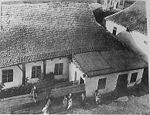 Synagogue of the Baal Shem Tov, founder of Hasidism, in Medzhybizh Ukraine. It gave a new phase to Jewish mysticism, seeking its popularisation through internal correspondence
Synagogue of the Baal Shem Tov, founder of Hasidism, in Medzhybizh Ukraine. It gave a new phase to Jewish mysticism, seeking its popularisation through internal correspondence
The 18th century saw an explosion of new efforts in the writing and spread of Kabbalah by four well known rabbis working in different areas of Europe:
- Rabbi Israel ben Eliezer, the Baal Shem Tov (1698–1760) in the area of Ukraine spread teachings based on Rabbi Isaac Luria's foundations, simplifying the Kabbalah for the common man. From him sprang the vast ongoing schools of Hasidic Judaism, with each successive rebbe viewed by his "Hasidim" as continuing the role of dispenser of mystical divine blessings and guidance.
- Rebbe Nachman of Breslov (1772–1810), the great-grandson of the Baal Shem Tov, revitalized and further expanded the latter's teachings, amassing a following of thousands in Ukraine, Belarus, Lithuania and Poland. In a unique amalgam of Hasidic and Mitnagid approaches, Rebbe Nachman emphasized study of both Kabbalah and serious Torah scholarship to his disciples. His teachings also differed from the way other Hasidic groups were developing, as he rejected the idea of hereditary Hasidic dynasties and taught that each Hasid must "search for the tzaddik ('saintly/righteous person')" for himself—and within himself.
- Rabbi Elijah of Vilna (Vilna Gaon) (1720–1797), based in Lithuania, had his teachings encoded and publicized by his disciples such as by Rabbi Chaim Volozhin who published the mystical-ethical work Nefesh HaChaim. However, he was staunchly opposed to the new Hasidic movement and warned against their public displays of religious fervour inspired by the mystical teachings of their rabbis. Although the Vilna Gaon was not in favor of the Hasidic movement, he did not prohibit the study and engagement in the Kabbalah. This is evident from his writings in the Even Shlema. "He that is able to understand secrets of the Torah and does not try to understand them will be judged harshly, may God have mercy". (The Vilna Gaon, Even Shlema, 8:24). "The Redemption will only come about through learning Torah, and the essence of the Redemption depends upon learning Kabbalah" (The Vilna Gaon, Even Shlema, 11:3).
- Rabbi Moshe Chaim Luzzatto (1707–1746), based in Italy, was a precocious Talmudic scholar who arrived at the startling conclusion that there was a need for the public teaching and study of Kabbalah. He established a yeshiva for Kabbalah study and actively recruited outstanding students and, in addition, wrote copious manuscripts in an appealing clear Hebrew style, all of which gained the attention of both admirers and rabbinical critics who feared another "Zevi (false messiah) in the making". He was forced to close his school by his rabbinical opponents, hand over and destroy many of his most precious unpublished kabbalistic writings, and go into exile in the Netherlands. He eventually moved to the Land of Israel. Some of his most important works such as Derekh Hashem survive and are used as a gateway to the world of Jewish mysticism.
Modern era
Orthodox
One of the most influential sources spreading Kabbalistic teachings have come from the massive growth and spread of Hasidic Judaism, a movement begun by Yisroel ben Eliezer (The Baal Shem Tov), but continued in many branches and streams until today. These groups differ greatly in size, but all emphasize the study of mystical Hasidic texts, which now consists of a vast literature devoted to elaborating upon the long chain of Kabbalistic thought and methodology. No group emphasizes in-depth kabbalistic study, though, to the extent of the Chabad-Lubavitch movement, whose Rebbes delivered tens of thousands of discourses, and whose students study these texts for three hours daily.
Rabbi Shmuel Schneersohn of Lubavitch urged the study of Kabbalah as prerequisite for one's humanity:
“ A person who is capable of comprehending the Seder hishtalshelus (kabbalistic secrets concerning the higher spiritual spheres)—and fails to do so—cannot be considered a human being. At every moment and time one must know where his soul stands. It is a mitzvah (commandment) and an obligation to know the seder hishtalshelus.[53] ” The writings of Rabbi Abraham Isaac Kook (1864–1935) also stress Kabbalistic themes:
“ Due to the alienation from the 'secret of God' [i.e. Kabbalah], the higher qualities of the depths of Godly life are reduced to trivia that do not penetrate the depth of the soul. When this happens, the most mighty force is missing from the soul of nation and individual, and Exile finds favor essentially... We should not negate any conception based on rectitude and awe of Heaven of any form—only the aspect of such an approach that desires to negate the mysteries and their great influence on the spirit of the nation. This is a tragedy that we must combat with counsel and understanding, with holiness and courage.
— Rabbi Avraham Yitzchak HaCohen Kook (Orot 2)” Bnei Baruch
Bnei Baruch is a group of Kabbalah students, based in Israel. Study materials are available in over 25 languages. Michael Laitman established Bnei Baruch in 1991, following the passing of his teacher, Baruch Ashlag. Laitman named his group Bnei Baruch (sons of Baruch) to commemorate the memory of his mentor. Baruch Ashlag was the oldest son and successor of the famous Kabbalist Rabbi Yehuda Ashlag, who was author of a comprehensive commentary on The Book of Zohar called The Sulam Commentary (The Ladder Commentary).
Kabbalah Centre
The Kabbalah Centre was founded in the United States in 1965 as The National Research Institute of Kabbalah by Philip Berg (born Feivel Gruberger) and Rav Yehuda Tzvi Brandwein. After Brandwein's death, and after several years in Israel, Philip Berg and his wife Karen Berg, re-established the U.S. Kabbalah Centre[54] in New York City.
Personalities in Kabbalah
See also: Category:Kabbalists- Historical
- Abraham Abulafia
- Abraham Azulai
- Baba Sali
- Baruch Ashlag
- Chaim Vital
- Elijah ben Solomon
- Nathan Adler
- Simeon bar Yohai
- Solomon ibn Gabirol
- Yehuda Ashlag
- Yitzchak Kaduri
- Yosef Karo
- Contemporary
- Samuel Ben-Or Avital
- Aryeh Kaplan
- Zalman Schachter-Shalomi
- Adin Steinsaltz
See also
- Christian Knorr von Rosenroth Christian Hebraist, author of the Kabbala Denudata, or Kabbala Unveiled
- Donmeh West
- Emanation (Eastern Orthodox Christianity)
- Hermetic Qabalah
- Practical Kabbalah
- Three hares
- History of the Jews in Spain
Notes
- ^ "Imbued with Holiness" - The relationship of the esoteric to the exoteric in the fourfold Pardes interpretation of Torah and existence. From www.kabbalaonline.org
- ^ Shnei Luchot HaBrit, R. Isaiah Horowitz, Toldot Adam, Beit haChokhma, 14
- ^ Jewishencyclopedia.com - ZOHAR
- ^ The Written Law (The Torah)
- ^ Megillah 14a, Shir HaShirim Rabbah 4:22, Ruth Rabbah 1:2, Aryeh Kaplan Jewish Meditation: A Practical Guide pp.44–48
- ^ Rabbi Yehuda Leib Ha-Levi Ashlag; Preface to the Wisdom of Truth p.12 section 30 and p.105 bottom section of the left column as preface to the "Talmud Eser HaSfirot"
- ^ See Shem Mashmaon by Rabbi Shimon Agasi. It is a commentary on Otzrot Haim by Haim Vital. In the introduction he list five major schools of thought as to how to understand the AriZ"L/Haim Vital's understanding of the concept of Tzitzum.
- ^ See Yechveh Daat Vol 3, section 47 by Rabbi Ovadiah Yosef
- ^ See Ktavim Hadashim published by Rabbi Yaakov Hillel of Ahavat Shalom for a sampling of works by Haim Vital attributed to Isaac Luria that deal with other works.
- ^ Kabbala goes to yeshiva | Jerusalem Post
- ^ This applies in Habad intellectual Hasidic philosophy, that incorporates Hakirah into its inner mystical philosophy. Some other Hasidic schools were opposed to Hakirah. In the synthesis, both Hakirah and Kabbalah are seen to unite within a higher Divine source of intellect.
- ^ Maimonides, beginning of the Mishneh Torah
- ^ "Maimonides: Philosopher and Mystic" from www.Chabad.org Maimonides' Kabbalistic scholarship has been explained especially in Chabad mystical works. Additionally, the source of some laws in his Mishneh Torah are only found in Kabbalah
- ^ Wineberg, chs. 20–21
- ^ (Scholem, Kabbalah, p. 100)
- ^ See Otzrot Haim: Sha'ar TNT"A for a short explanation. The vast majority of the Lurianic system deals only with the complexities found in the world of Atzilut as is explained in the introductions to both Otzrot Haim and Eitz Haim.
- ^ The Song of the Soul, Yechiel Bar-Lev, p.73
- ^ J.H.Laenen, Jewish Mysticism, p.164
- ^ (Otzar Eden Ganuz, Oxford Ms. 1580, fols. 163b-164a; see also Hayei Haolam Haba, Oxford 1582, fol. 12a)
- ^ Sirach iii. 22; compare Talmud, Hagigah, 13a; Midrash Genesis Rabbah, viii.
- ^ Overview of Hasidut from www.inner.org
- ^ The Founder of Hasidism, the Baal Shem Tov, cautioned against the layman learning Kabbalah without its Hasidic explanation. He saw this as the cause of the contemporary mystical heresies of Sabbatai Zevi and Jacob Frank. Cited in The Great Maggid by Jacob Immanuel Schochet, quoting Derech Mitzvosecha by Menachem Mendel Schneersohn
- ^ Moshe Idel
- ^ Daniel C. Matt
- ^ Gerschom Scholem, "Hasidism: The Latest Phase" in Major Trends in Jewish Mysticism and Martin Bubuer, Hasidism and Modern Man and The Origin and Meaning of Hasidism
- ^ Sitra Achra
- ^ Chabad.org: Kelipot and Sitra Achra, Nissan Dovid Dubov Chabad.org
- ^ Arich Anpin
- ^ Fundamentals of Jewish Mysticism and Kabbalah By Ron H. Feldman. Pg. 59
- ^ סידור הרב, שער אכילת מצה
- ^ a b Dov Ber Pinson, Reincarnation and Judaism
- ^ ר' אברהם חן, ביהדות התורה
- ^ article, The Seductiveness of Jewish Myth
- ^ Love of one's Neighbour in Pinhas Hurwitz's Sefer ha-Berit, Resianne Fontaine, Studies in Hebrew Language and Jewish Culture, Presented to Albert van der Heide on the Occasion of his Sixty-Fifth Birthday, p.244-268.
- ^ Israel and Humanity, Elijah Benamozegh, Paulist Press, 1995
- ^ Wolfson, E.R. Venturing Beyond: Law and Morality in Kabbalistic Mysticism, Oxford University Press, 2006, ch.1.
- ^ Rabbi Bradley Shavit Artson, From the Periphery to the Center: Kabbalah & Conservative Judaism
- ^ a b Artson, Bradley Shavit. From the Periphery to the Centre: Kabbalah and the Conservative Movement, United Synagogue Review, Spring 2005, Vol. 57 No. 2
- ^ Introduction to Raziel Hamalach
- ^ Stern, Schneur Zalman. Active vs. Passive Meditation
- ^ SparkNotes: The Kabbalah: Ma’aseh merkavah
- ^ SparkNotes: The Kabbalah: Ma’aseh bereshit
- ^ Urbach, The Sages, pp.184ff.
- ^ Later, Elisha came to be considered heretical by his fellow Tannaim and the rabbis of the Talmud referred to him as Acher (אחר"The Other One").
- ^ Babylonian Talmud Hagigah 14b, Jerusalem Talmud Hagigah 2:1. Both available online in Aramaic: Babylonian Talmud, Jerusalem Talmud. This translation based on Braude, Ginzberg, Rodkinson, and Streane.
- ^ A. W. Streane, A Translation of the Treatise Chagigah from the Babylonian Talmud Cambridge University Press, 1891. p. 83.
- ^ Louis Ginzberg, Elisha ben Abuyah", Jewish Encyclopedia, 1901–1906.
- ^ The Zohar
- ^ Rabbi Avraham Azulai quoted in Erdstein, Baruch Emanuel. The Need to Learn Kabbala
- ^ The Kabbalah Centre
- ^ Shulhan Arukh YD 246:4
- ^ Shulhan Arukh 246:4 S"K 19
- ^ Sefer HaToldos Admur Maharash: From The Sichos Of The Rebbe Maharash Nshmoso Eden
- ^ Kabbalah.com
References
- Bodoff, Lippman; "Jewish Mysticism: Medieval Roots, Contemporary Dangers and Prospective Challenges"; The Edah Journal 2003 3.1
- Dan, Joseph; The Early Jewish Mysticism, Tel Aviv: MOD Books, 1993.
- Dan, Joseph; The Heart and the Fountain: An Anthology of Jewish Mystical Experiences, New York: Oxford University Press, 2002.
- Dan, Joseph; "Samael, Lilith, and the Concept of Evil in Early Kabbalah", AJS Review, vol. 5, 1980.
- Dan, Joseph; The ‘Unique Cherub’ Circle, Tübingen: J.C.B. Mohr, 1999.
- Dan, J. and Kiener, R.; The Early Kabbalah, Mahwah, N.J.: Paulist Press, 1986.
- Dennis, G.; The Encyclopedia of Jewish Myth, Magic, and Mysticism, St. Paul: Llewellyn Worldwide, 2007.
- Fine, Lawrence, ed. Essential Papers in Kabbalah, New York: NYU Press, 1995.
- Fine, Lawrence; Physician of the Soul, Healer of the Cosmos: Isaac Luria and his Kabbalistic Fellowship, Stanford: Stanford University Press, 2003.
- Fine, Lawrence; Safed Spirituality, Mahwah, N.J.: Paulist Press, 1989.
- Fine, Lawrence, ed., Judaism in Practice, Princeton N.J.: Princeton University Press, 2001.
- Green, Arthur; EHYEH: A Kabbalah for Tomorrow. Woodstock: Jewish Lights Publishing, 2003.
- Grözinger, Karl E., Jüdisches Denken Band 2: Von der mittelalterlichen Kabbala zum Hasidismus, (Campus) Frankfurt /New York, 2005
- Hecker, Joel; Mystical Bodies, Mystical Meals: Eating and Embodiment in Medieval Kabbalah. Detroit: Wayne State University Press, 2005.
- Idel, Moshe; Kabbalah: New Perspectives. New Haven and London: Yale University Press, 1988.
- Idel, Moshe; The Golem: Jewish Magical and Mystical Traditions on the Artificial Anthropoid, New York: SUNY Press, 1990.
- Idel, Moshe; Hasidism: Between Ecstasy and Magic, New York: SUNY Press, 1995.
- Idel, Moshe; Kabbalistic Prayer and Color, Approaches to Judaism in Medieval Times, D. Blumenthal, ed., Chicago: Scholar's Press, 1985.
- Idel, Moshe; The Mystica Experience in Abraham Abulafia, New York, SUNY Press, 1988.
- Idel, Moshe; Kabbalah: New Perspectives, New Haven, Yale University Press, 1988.
- Idel, Moshe; Magic and Kabbalah in the ‘Book of the Responding Entity’; The Solomon Goldman Lectures VI, Chicago: Spertus College of Judaica Press, 1993.
- Idel, Moshe; "The Story of Rabbi Joseph della Reina"; Behayahu, M. Studies and Texts on the History of the Jewish Community in Safed.
- This article incorporates text from the 1901–1906 Jewish Encyclopedia, a publication now in the public domain.
- Kaplan, Aryeh; Inner Space: Introduction to Kabbalah, Meditation and Prophecy. Moznaim Publishing Corp 1990.
- John W. McGinley; 'The Written' as the Vocation of Conceiving Jewishly
- Samuel, Gabriella; "The Kabbalah Handbook: A Concise Encyclopedia of Terms and Concepts in Jewish Mysticism". Penguin Books 2007.
- Scholem, Gershom; Major Trends in Jewish Mysticism, 1941.
- Scholem, Gershom; Jewish Gnosticism, Merkabah Mysticism, and the Talmudic Tradition, 1960.
- Scholem, Gershom; Sabbatai Zevi, the Mystical Messiah, 1973.
- Scholem, Gershom; Kabbalah, Jewish Publication Society, 1974.
- Wineberg, Yosef; Lessons in Tanya: The Tanya of R. Shneur Zalman of Liadi (5 volume set). Merkos L'Inyonei Chinuch, 1998.
- Wirszubski, Chaim; Pico della Mirandola's Encounter with Jewish Mysticism, Harvard University Press, 1989.
- Wolfson, Elliot; Through a Speculum That Shines: Vision and Imagination in Medieval Jewish Mysticism, Princeton: Princeton University Press, 1994.
- Wolfson, Elliot; Language, Eros Being: Kabbalistic Hermeneutics and Poetic Imagination, New York: Fordham University Press, 2005.
- Wolfson, Elliot; Venturing Beyond: Law and Morality in Kabbalistic Mysticism, Oxford: Oxford University Press, 2006.
- Wolfson, Elliot; Alef, Mem, Tau: Kabbalistic Musings on Time, Truth, and Death, Berkeley: University of California Press, 2006.
- Wolfson, Elliot; Luminal Darkness: Imaginal Gleanings From Zoharic Literature, London: Onworld Publications, 2007.
- The Wisdom of The Zohar: An Anthology of Texts, 3 volume set, Ed. Isaiah Tishby, translated from the Hebrew by David Goldstein, The Littman Library.
External links
- General information sites
- Kabbalah Dictionary 5300 terms and concepts each with indications of Notariqon, Gematria and Atbash
- Resources > Medieval Jewish History > Jewish Mysticism Jewish History Resource Center
- FAQ about Kabbalah JewFaq.org
- Cabala Jewishrncyclopedia.com
- Bibliographic Surveys of Books on Jewish Mysticism in English
- Rabbinic Kabbalah texts in English
- Kabbalah for beginners. All questions been answered
- Lists of Kabbalah terms
- Glossary of kabbalistic terms Bnei Baruch
- Central terms and concepts in Kabbalah neohasid.org
- Kabbalah study groups
- Kabbalah TV – Bnei Baruch Kabbalah Education & Research Institute kab.tv
- Bnei Baruch Education and Research Institute Kabbalah.info
- The Kabbalah Centre Kabbalah.com
- European Institute of Kabbalah Eurokab.org
- Ascent-of-Sefad
- Authentic Kabbalah
- Kabbalah Healing Kabbalah Healing
- Online rabbinic Kabbalah texts
- Who Should Learn the Hidden Torah? Rambam (Maimonides), Guide for the Perplexed.
- English and Aramaic Zohar Online (searchable) Kabbalah Centre
- Kabbalah Library Bnei Baruch
- Important Kabbalah texts in English KabbalahOnline.org
- Jewish sites - Liberal
- LearnKabbalah Jay Michaelson's site
- Jewish sites - Orthodox
- Kabbalah and Jewish Mysticism Talmudist perspective of Kabbalah
- What is Kabbalah? Chabad
- Kabbalah 101 Aish
- A-Z Kabbalah Institute
- Bircat Shalom
- Online Hasidic Kabbalah texts
- letter of the Baal Shem Tov
- Lessons in Tanya Chabad
- The Gate Of Unity Translation & Commentary of The Gate Of Unity
- Jewish criticisms of Kabbalah
- Anti-Maimonidean Demons Article by José Faur
- Maimonides Agonist: Disenchantment and Reenchantment in Modern Judaism Article by Menachem Kellner
- Milhamot Hashem Attack on the Zohar by Yihhyah Qafahh. Hebrew
- Emunat Hashem Reply to Milhamot Hashem by Jerusalem rabbis. Hebrew
- Other
Jews and Judaism Religious movements Orthodox (Hardal · Haredi · Hasidic · Modern Orthodox) · Musar movement · Neolog · Conservative (Conservadox) · Reform · Reconstructionist · Jewish Renewal · Rabbinic · Karaite · Samaritan · Humanistic · Schisms · Intra-Jewish relations · Jewish atheismPhilosophy Principles of faith · Chosen people · Eschatology · Ethics · Halakha · Holocaust theology · Kabbalah · Kashrut · Messianism · Names of God · Seven Laws of Noah · Tzedakah · TzniutReligious texts Chumash · Tanakh (Torah · Nevi'im · Ketuvim) · Mishnah · Talmud · Tosefta · Midrash · Rabbinic works · Mishneh Torah · Arba'ah Turim · Shulchan Aruch · Mishnah Berurah · Zohar · Passover Haggadah · Piyyut · SiddurBiblical figures Jewish leadership Hillel · Shammai · Yehudah haNasi · Saadia Gaon · Gershom ben Judah · Isaac Alfasi · Rashi · Judah Halevi · Abraham ibn Ezra · Tosafists · Maimonides · Nahmanides · Asher ben Jehiel · Gersonides · Joseph Albo · Isaac Abrabanel · Isaac Luria · Baal Shem Tov · Vilna Gaon · Moses Mendelssohn · Leopold Zunz · Samson Raphael Hirsch · Abraham Geiger · Solomon SchechterLife and culture Roles and places Four Holy Cities (Jerusalem · Tzfat · Hebron · Tiberias) · Beth din · Gabbai · Hazzan · Kohen · Maggid · Mashgiach · Mikvah · Mohel · Rabbi · Rebbe · Rosh yeshiva · Synagogue · Temple · Tabernacle · Western WallReligious articles
and prayersInteractions with
other religionsJewish views on religious pluralism · Abrahamic religions · Christianity (Catholicism · Christian-Jewish reconciliation · Judeo-Christian · Mormonism · Messianic Judaism) · Islam · Jewish Buddhist · Judeo-Paganism · Black Hebrew Israelites · Kabbalah Centre · OthersLanguages History Ancient · Temple in Jerusalem · Babylonian captivity · Jerusalem (Significance · Timeline) · Hasmonean · Herod · Sanhedrin · Pharisees · Sadducees · Essenes · First Jewish–Roman War · Bar Kokhba revolt · Diaspora · Middle Ages · Muslim rule · Sabbateans · Haskalah · Emancipation · The Holocaust · Aliyah · History of Zionism · History of Israel · Arab-Israeli / Israeli–Palestinian conflicts · Land of Israel · Baal teshuva movement · Judaism by countryPolitics Israel · Zionism · (General · Labor · Religious · Revisionist) · Political movements (Jewish left · Jewish right · Jewish anarchism) · Bundism · World Agudath Israel · Feminism · Politics of IsraelAntisemitism Categories:- Hebrew words and phrases
- Jewish mysticism
- Kabbalah
- Panentheism
Wikimedia Foundation. 2010.






